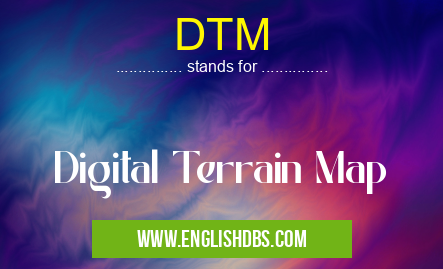What does DTM mean in ELECTRONICS
Digital Terrain Map (DTM) is an important concept in the field of science. It is a digital representation of terrain features on the earth’s surface that can be used to map, analyze, and interpret various aspects of the landscape. The main purpose of DTM is to provide a visual representation of terrain features and characteristics for further analysis and decision-making. The data contained within a DTM can be used to identify surface detail or to build 3D models of landforms. It can also be used to inform the design of infrastructure projects such as roads, sewers, and buildings.

DTM meaning in Electronics in Academic & Science
DTM mostly used in an acronym Electronics in Category Academic & Science that means Digital Terrain Map
Shorthand: DTM,
Full Form: Digital Terrain Map
For more information of "Digital Terrain Map", see the section below.
Definition
DTM stands for Digital Terrain Map, which is a digital representation of topographic features like terrain elevation, slope gradient, land cover, etc. It is created using sophisticated computer software programs and relies on the use of remotely sensed data such as LiDAR (Light Detection And Ranging) or SRTM (Shuttle Radar Topography Mission). DTMs are typically stored in GIS (Geographic Information Systems) formats such as vectors or rasters and allow for complex spatial analysis of geographical information including elevation data.
Uses
DTMs are used in many disciplines in order to map physical features across large areas quickly and accurately. The most common applications involve forestry management plans, assessing land suitability for development projects, military operations planning or environmental monitoring. DTMs also provide information about elevation levels that can be useful for creating flood risk maps or analyzing hydrological patterns. In addition, DTMs can help planners determine optimal locations for construction while avoiding hazardous sites due to changes in topography such as steep slopes or slumping ground conditions.
Benefits
DTMs are beneficial because they offer high accuracy with detailed visuals since all topographical information from different sources can be integrated into one file format. Additionally, DTMs give users the ability to measure surface heights easily with accurate results due to their highly precise details. This accurate benchmarking feature helps professionals make better decisions regarding project locations as well as helps them evaluate risks associated with them. Finally, they are very effective at providing detailed insights into how terrain affects site layouts - making them valuable tools for geological mapping and natural hazard assessment studies.
Essential Questions and Answers on Digital Terrain Map in "SCIENCE»ELECTRONICS"
What is a Digital Terrain Map (DTM)?
A Digital Terrain Map (DTM) is a digital representation of land surface terrain features that can be used to create accurate models and simulations for a variety of applications. It captures the behavior, shape, elevation, and details of terrain and can be used to analyze landscape changes due to natural or man-made forces.
What are the key components of DTM?
The key components of DTM include elevation, slope, aspect, roughness, ruggedness index, curvature and hillshade. These components allow for accurate analysis and modelling of landforms in three dimensions.
What is the application range for DTM?
DTM has several applications including hydrologic analysis for flood control and construction design; ecological evaluation; visual impact assessment; geotechnical analyses such as landslides and subsidence hazard mapping; and archaeological prospecting.
How is DTM generated?
DTM can be created from aerial photography or airborne laser scanning (lidar). Aerial photography involves taking aerial photographs from different angles and processing these images into a 3D representation of the terrain while lidar uses lasers to collect precise measurements about elevation points on the ground.
How accurate is DTM?
Accuracy will depend on several factors including the data collection method used (e.g., aerial photography or lidar), resolution accuracy (the fineness with which features are represented), vertical accuracy (the accuracy with which elevations are represented), horizontal accuracy (the precision with which locations are represented), data integrity (data loss due to transmission errors) and temporal accuracy (time-sensitive changes in the environment). Generally speaking, higher resolution datasets provide more detailed models than lower resolution datasets but come at an increased cost.
Who uses DTMs?
DTMs are used by engineers, planners, architects, conservationists, urban designers or anyone who needs a detailed view of terrain features for their work projects or research studies.
Can I access DTMs publicly?
Yes! There are many publicly available datasets that you can access online through various sources such as government websites or open source repositories like Open Street Maps. It's important to note that public datasets may not always have the same level of detail as a professionally generated dataset so it’s best to double check before using them in any critical analysis.
Can I generate my own DTMs?
Yes! You can generate your own DTMs by collecting data from satellite imagery manually or by using software programs such as ArcGIS or Google Earth Pro which allow you to generate your own high-resolution maps instantly from satellite images.
How often should I update my DTM maps?
This depends on how often you use them for planning purposes but typically it’s recommended that you update your maps at least once every year since terrain features may change over time due to natural processes such as erosion or human activities such as construction projects occurring nearby. In some cases it may even be necessary to update them every few months if there’s been rapid changes in landform characteristics.
Final Words:
Digital Terrain Maps are essential tools for scientists today due to their accuracy and level of detail they provide when mapping physical features across areas quickly and precisely. They offer numerous benefits by helping professionals analyze landscapes more accurately than ever before - reducing risks associated with construction projects while ensuring safety measures are taken where necessary.
DTM also stands for: |
|
| All stands for DTM |
